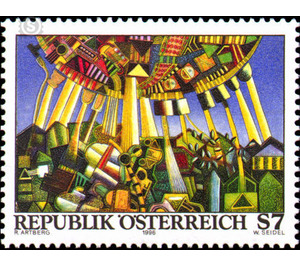Modern Art - Austria / II. Republic of Austria 1996 - 7 Shilling
Theme: Art & Culture
| Country | Austria / II. Republic of Austria |
| Issue Date | 1996 |
| Face Value | 7.00 |
| Color | multi-colored yellow blue |
| Printing Type | combination printing |
| Stamp Type | Commemorative |
| Item Type | Stamp |
| Chronological Issue Number | 1549 |
| Chronological Chapter | OOS-OE2 |
| SID | 369551 |
| In 64 Wishlists | |
Power Station by Reinhard Artberg, a renowned representative of modern art in Austria, forms the motif of this special postage stamp. Artberg, born in Tyrol in 1955, started a technical career for the time being. Soon, however, he gave in to his artistic talent and traveled for years painting throughout Europe, until he finally began studying in 1976 at the Academy of Fine Arts in Vienna. Just four years later, Artberg came to the public with objects and ironic-critical machine designs. His bizarre constructions, which attracted much attention, were profound and ambiguous. Disillusioned with the local art scene, he lived in Normandy for many months a year from 1986 to 1995, working there concentratedly. Most of his large-format works were created in this enclave. Critical themes with mysterious colors as well as Artberg's typical fantasy worlds with hidden symbolism were the focus of his 10-year work in France. Artberg developed and refined his design language from technical-seeming elements. He likes to juggle with the interaction of surfaces, lines, symbols and set pieces of the real. He often blends this interplay into decorative patterns. Artberg's versatility lets him wander between the most contradictory techniques and themes.


